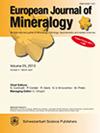Optimal Raman-scattering signal for estimating the Fe3+ content on the clinozoisite–epidote join
IF 1.7
3区 地球科学
Q2 MINERALOGY
引用次数: 1
Abstract
Abstract. To provide a tool for fast estimation of the Fe3+ content in Ca2(Al, Fe3+)3Si3O12(OH) epidote grains, including in thin sections and crude-rock samples, we applied Raman spectroscopy to 33 areas from 15 natural samples with Fe3+ ranging from 0.22 to 1.13 atoms per formula unit (apfu), the chemistry of which was independently determined by wavelength-dispersive electron microprobe analysis (WD-EPMA). The Raman spectra were collected from the very areas subjected to WD-EPMA. We have analysed both the OH-stretching region (3215–3615 cm−1) and the spectral range generated by the framework vibrations (15–1215 cm−1). Similarly to the IR spectra, the Raman peaks in the OH-stretching region shift toward higher wavenumbers with increasing Fe. However, the quantification of Fe3+ based on OH-stretching Raman peaks can be hindered by the multicomponent overlapping and significant intensity variations with the crystal orientation. Among the Raman signals generated by framework vibrations, the position of four peaks (near 250, 570, 600, and 1090 cm−1) exhibit a steady linear regression with the increase in Fe content (in apfu). However, the peak near 250 cm−1 attributed to MO6 vibrations also depends on the crystal orientation and therefore is not always well resolved, which worsens the accuracy in Fe-content determination based on its position. The peaks near 570, 600, and 1090 cm−1 arise from Si2O7 vibrational modes, and although their intensities also vary with the crystal orientation, all three signals are well resolved in a random orientation. However, among the three Si2O7-related signals, the 570 cm−1 peak is the sharpest (peak width <10 cm−1) and is easily recognized as a separate peak. Hence, we propose to use the position of this peak as a highly reliable parameter to estimate the Fe content, via the linear trend given as ω570=577.1(3)-12.7(4)x, where ω is the wavenumber (cm−1) and x is Fe content (apfu), with accuracy ± 0.04 Fe3+ apfu. The peaks near 600 and 1090 cm−1 may be complementarily used for the Fe estimate, based on the following relations: ω600=611.6(2)-13.8(4)x and ω1090=1098.8(3)-13.5(5)x. Analyses of the effect of Sr as a substitution for Ca and Cr at the octahedral sites indicate that contents of Sr <0.12 apfu do not interfere with the quantification of Fe via the ω570 (x) relation, whereas Cr >0.16 apfu leads to overestimation of Fe; Cr presence can be recognized however by the broadening of the peaks near 95 and 250 cm−1.估算斜云母-绿帘石结合部Fe3+含量的最佳拉曼散射信号
摘要为了提供一种快速估计Ca2(Al, Fe3+)3Si3O12(OH)绿橄榄石颗粒(包括薄片和原始岩石样品)中Fe3+含量的工具,我们对15个天然样品中的33个区域进行了拉曼光谱分析,这些样品的Fe3+含量范围从0.22到1.13个原子/公式单位(apfu),其化学成分由波长色散电子探针分析(pd - epma)独立确定。拉曼光谱是在受WD-EPMA作用的区域收集的。我们分析了oh -拉伸区域(3215-3615 cm−1)和框架振动产生的光谱范围(15-1215 cm−1)。与红外光谱相似,随着铁的增加,oh -拉伸区的拉曼峰向更高的波数移动。然而,基于oh -拉伸Ramanpeaks的Fe3+定量会受到多组分重叠和明显的晶体取向强度变化的阻碍。在骨架振动产生的拉曼信号中,四个峰(250,570,600和1090cm−1附近)的位置随着铁含量的增加(在apfu中)呈现稳定的线性回归。然而,由于MO6振动引起的250 cm−1附近的峰值也取决于晶体取向,因此并不总是很好地解决,这降低了基于其位置的fe含量测定的准确性。570,600和1090cm−1附近的峰值来自Si2O7振动模式,尽管它们的强度也随晶体取向而变化,但这三个信号在随机方向上都能很好地分辨出来。然而,在三个esi2o7相关信号中,570 cm−1的峰是最尖锐的(峰宽0.16 apfu会导致铁的高估;Cr的存在可以通过95和250 cm−1附近的峰变宽来识别。
本文章由计算机程序翻译,如有差异,请以英文原文为准。
求助全文
约1分钟内获得全文
求助全文
来源期刊
CiteScore
2.80
自引率
9.50%
发文量
40
审稿时长
6-12 weeks
期刊介绍:
EJM was founded to reach a large audience on an international scale and also for achieving closer cooperation of European countries in the publication of scientific results. The founding societies have set themselves the task of publishing a journal of the highest standard open to all scientists performing mineralogical research in the widest sense of the term, all over the world. Contributions will therefore be published primarily in English.
EJM publishes original papers, review articles and letters dealing with the mineralogical sciences s.l., primarily mineralogy, petrology, geochemistry, crystallography and ore deposits, but also biomineralogy, environmental, applied and technical mineralogy. Nevertheless, papers in any related field, including cultural heritage, will be considered.

 求助内容:
求助内容: 应助结果提醒方式:
应助结果提醒方式:


